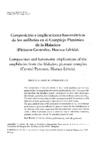Mostrar o rexistro simple do ítem
Composición e implicaciones barométricas de los anfíboles en el Complejo Plutónico de la Maladeta (Pirineos Centrales, Huesca-Lérida)
| dc.contributor.author | Arranz Yagüe, E. | |
| dc.contributor.author | Lago San José, M. | |
| dc.contributor.author | Corretgé, L. G. | |
| dc.date.accessioned | 2010-01-22T13:23:34Z | |
| dc.date.available | 2010-01-22T13:23:34Z | |
| dc.date.issued | 1995 | |
| dc.identifier.citation | Cadernos do Laboratorio Xeolóxico de Laxe, 1995, 20: 167-179 ISSN: 0213-4497 | es_ES |
| dc.identifier.issn | 0213-4497 | |
| dc.identifier.uri | http://hdl.handle.net/2183/6203 | |
| dc.description.abstract | [Abstract] The composition of the amphiboles in basic rocks (gabbros and diorites), granodiorites, monzogranites with minor amphibole and mafic microgranular enclaves from the Maladetta massif, corresponds to calcic terms (magnesioHornblende, actinolitic hornblende and actinolite), with reduced values ofAl tot• The main substitutional types are edenite, pargasite and Ti-Tschermakite, with other minor types, generating compositions with an AIIV excess. The application of three of the proposed calibrations for the Altot in Horblende geobarometer, gives anomalously low pressure values for the cristallyzation of the plutonic rock-types, suggesting that the amphibole crystals were formed below 2 Kbar of pressure, and in a continous way to subsolidus conditions,probably at the same time as AI-saturating phases formed. | |
| dc.language.iso | spa | es_ES |
| dc.publisher | Universidade da Coruña | es_ES |
| dc.subject | Calcic amphiboles | es_ES |
| dc.subject | Geobarometry | es_ES |
| dc.subject | Total Al | es_ES |
| dc.subject | Granitoids | es_ES |
| dc.title | Composición e implicaciones barométricas de los anfíboles en el Complejo Plutónico de la Maladeta (Pirineos Centrales, Huesca-Lérida) | es_ES |
| dc.title.alternative | Composition and barometric implications of the amphiboles from the Maladeta plutonic complex (Central Pyrenees, Huesca-Lérida) | |
| dc.type | info:eu-repo/semantics/article | es_ES |
| dc.rights.access | info:eu-repo/semantics/openAccess |






